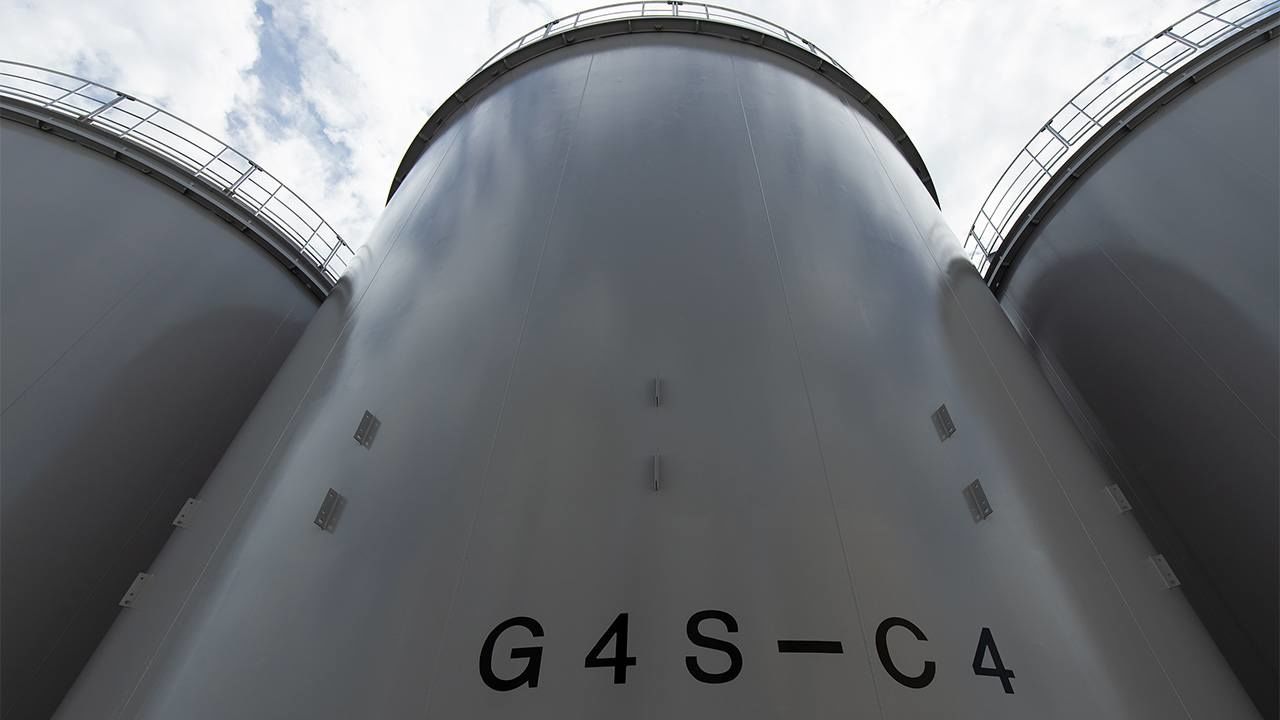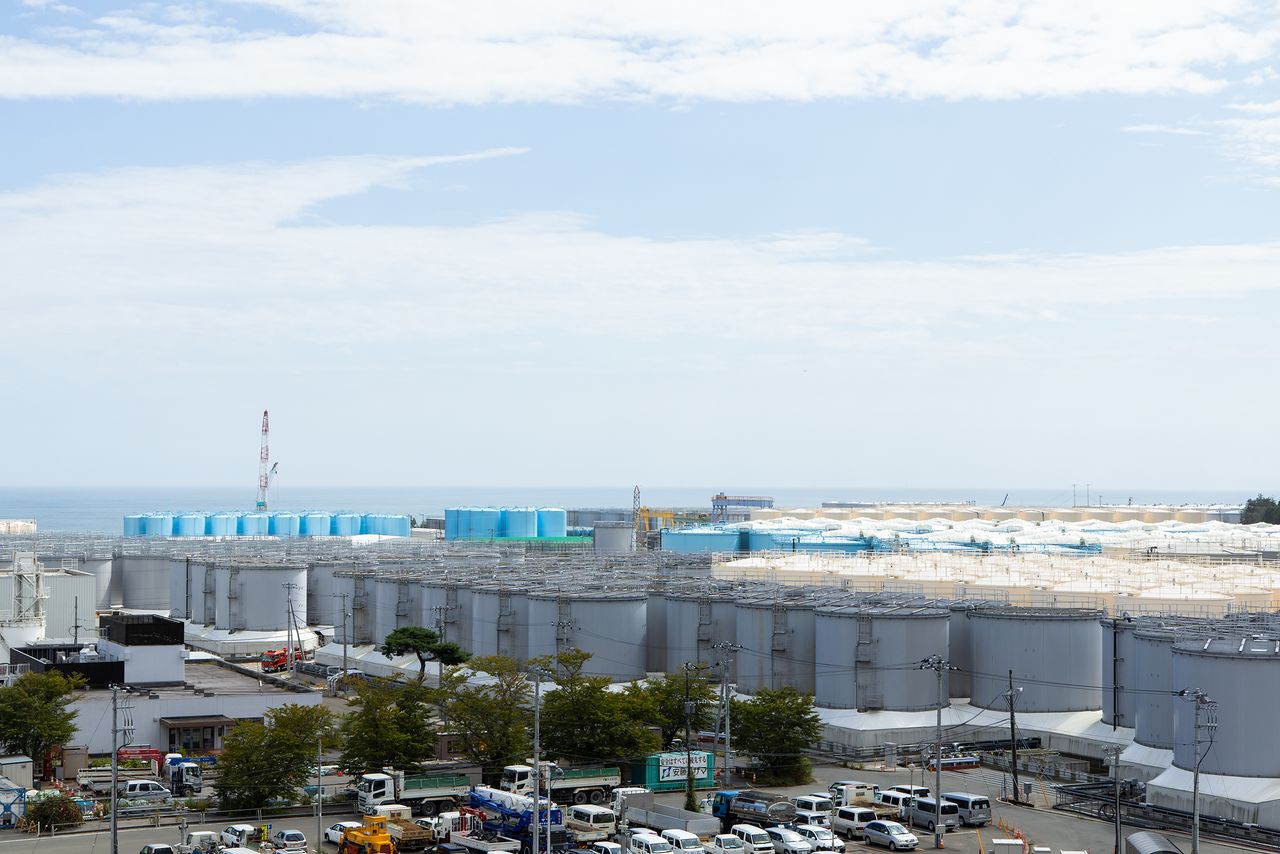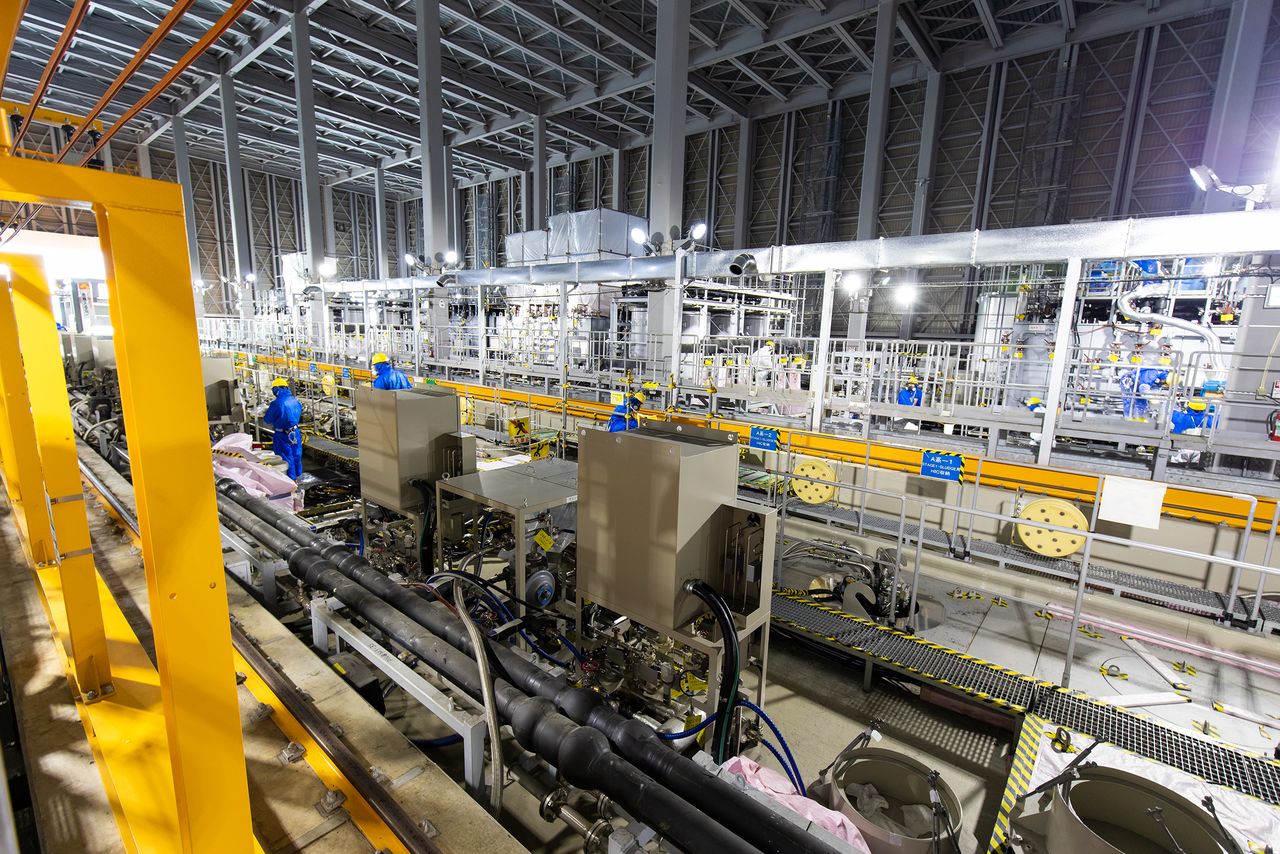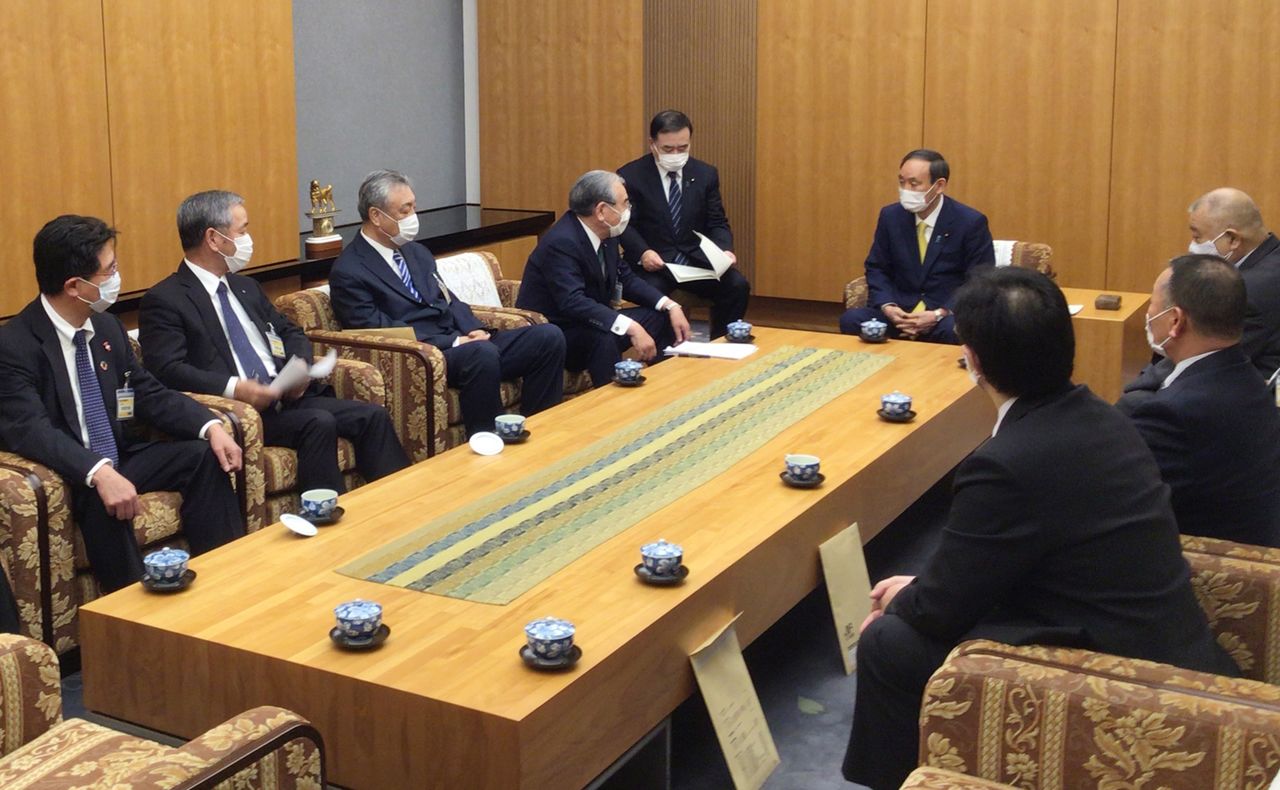
Ten Years of Stalling on Radioactive Water
Politics Society- English
- 日本語
- 简体字
- 繁體字
- Français
- Español
- العربية
- Русский
On April 13, 2021, the Japanese government officially agreed to release into the sea the “treated water” that was being kept in tanks of the Fukushima Daiichi Nuclear Power Station operated by the Tokyo Electric Power Company (TEPCO). The Fukushima Prefectural Federation of Fisheries Cooperative Associations and Japan Fisheries Cooperatives protested the decision, which they said was guaranteed to damage Fukushima’s reputation. And while the US government supported the decision, the governments of Japan’s neighbors, including South Korea, China, Taiwan, and Russia, expressed criticism and concern.

Almost all available space at the TEPCO Fukushima Daiichi Nuclear Power Station has been taken up by storage tanks.
As a matter of fact, as early as July 24, 2013, then Nuclear Regulation Authority chair Tanaka Shun’ichi explicitly stated that if the treatment process was able to lower radioactivity levels in the contaminated water to below Japan’s legal limit, the discharge of the water was unavoidable. The head of an International Atomic Energy Agency delegation to Japan also said on December 4, 2013, that the water should be discharged into the sea on the condition that consent was obtained from related parties. While the government takes the position that the water is safe to discharge, it took nearly eight years to reach a decision on the matter. What’s more, opposition to the release of the water has not gone away. In this article, I examine the issues surrounding the “treated water” while looking back over the sequence of events that lead to the decision to discharge it into the sea.
Understanding “Treated Water”
In Units 1, 2 and 3 of the Fukushima Daiichi plant, water continually cools mounds of radioactive debris that were formed when molten fuel rods flowed down from the reactor core. Damage to containment vessels means that water that has been in contact with this debris leaks out of the containment vessels and mixes with groundwater that has seeped into the reactor buildings through gaps in the basement structure, with the result that a large volume of water contaminated with high-level radioactive material has accumulated in the reactor buildings. The volume of contaminated water generated at the site in a single day peaked in May 2014 at 540 metric tons. While TEPCO was subsequently able to reduce this volume by drawing groundwater from wells surrounding the reactor building and creating an underground wall of frozen earth, as of 2020, 140 tons per day of contaminated water were still being generated at the site.
TEPCO refers to contaminated water that has been treated in its multi-nuclide removal system (Advanced Liquid Processing System) to bring levels of radioactive isotopes (other than tritium) down to below legal limits as “ALPS-treated water.” It should be mentioned that ALPS not only initially experienced malfunctions and failed to adequately remove isotopes, but the adsorbents used to remove radioactive isotopes were replaced less frequently than they were supposed to be to extend the life of the system. As a result, 70% of the water in the storage tanks still contains concentrations of nontritium radioactive isotopes above legal limits, including radioactive cesium, strontium, and iodine. TEPCO refers to this water as “undergoing processing.”

ALPS is able to remove 62 different radioactive isotopes.
The treated water is stored in a battery of 1,061 tanks on the Fukushima Daiichi grounds that as of October 28, 2021, contained 1.28 million metric tons of water. TEPCO says that the tanks have a total capacity of around 1.4 million tons, and will be completely full by early 2023. The company asserts that it is not possible to build more tanks on the site, as space needs to be allowed for other structures required in the decommissioning process. It is projected that it will take two years to formulate a concrete plan for discharging the water, so the decision to discharge was last minute.
In regard to the safety of discharging tritium, which ALPS cannot remove, the position of the Ministry of Economy, Trade, and Industry may be summarized as follows.
Tritium is a radioactive isotope of hydrogen. Because tritium’s chemical properties are almost identical to those of regular hydrogen (protium), separating tritiated water (tritium oxide) from regular water is technically challenging. Because tritium decay produces very low levels of radiation, however, tritium tends not to bioaccumulate. In fact, both overseas and in Japan, nuclear power stations routinely discharge tritium into the ocean, with a typical Japanese power station releasing anywhere from hundreds of billions to hundreds of trillions of becquerels of tritium into the ocean every year. During the test operation of the Rokkasho Village reprocessing plant in Aomori Prefecture, 1.3 quadrillion becquerels were released. According to the government, none of these discharges has caused any adverse health effects.
According to the government’s basic policy on treated water, water that is still “undergoing processing” will be reprocessed with ALPS to bring levels of radioactive materials (other than tritium) below the legal limit. The water will then be further diluted with seawater to reduce the tritium concentration to no more than 1,500 becquerels per liter, which is 40 times below the legal limit, before being discharged into the sea. Initially, a series of small discharges will be performed to monitor the impact on the environment. The amount of tritium discharged each year will be set at a level below the 22 trillion becquerel maximum that Fukushima Daiichi was allowed to release before the accident, and reviewed periodically. To ensure credibility, the IAEA will cooperate with the analysis of environmental monitoring results. In the event that the release of treated water results in reputational damage, TEPCO will compensate those affected and respond in a rapid and appropriate manner, commensurate with the nature of the damage incurred, and no limits will be imposed on time periods, regions, or industries eligible for compensation. The government will also assist by promoting agricultural produce and attempting to attract tourists to the region.
Past Failings Earn Distrust from Fishing Industry
While the government claims that, scientifically speaking, the discharge of treated water does not present a risk, fisheries operators are resolutely opposed, fearing reputational damage. Part of the reason for the strength of the opposition is the government’s and TEPCO’s record of bungling on this issue. Specifically, TEPCO discharged 11,500 metric tons of low-level contaminated water over several days beginning on April 4, 2011. This action was taken to free up capacity to store more heavily contaminated water that had been running into the sea, and was met with agreement from the government. However, TEPCO did not warn fisheries operators about the planned discharge, and levels of radioactive material above the legal limit were subsequently observed in sand eels caught off the coast of Ibaraki Prefecture, causing the market price of fish to crash. Fisheries operators were therefore angered by TEPCO’s action. Neighboring countries also strongly criticized the lack of advance warning.
In order to reduce the amount of contaminated water being produced on the site, it was agreed that from September 2015, groundwater would be drawn to the surface via a network of wells surrounding the reactor buildings and processed using ALPS to reduce levels of radioactive materials before being discharged into the sea. While the Fukushima Prefectural Federation of Fisheries Cooperative Associations voiced opposition, fearing reputational damage, it reluctantly gave its consent to the discharge so that the amount of contaminated water being stored on the site could be reduced. However, in return for its consent, the Federation demanded that contaminated water from inside the reactor building would never be dumped at sea, treated or otherwise. TEPCO and the government responded by issuing a written statement promising not to dispose of any water without the consent of related parties. This expedient response from the government and TEPCO would end up making future decisions more difficult.
In August 2018, the media reported that the ALPS-treated water in the tanks contained levels of residual radioactive material that exceeded legal limits. TEPCO responded by stating that of the approximately 890,000 tons of treated water stored in the tanks at the time, 750,000 tons contained levels of radioactive materials (other than tritium) that exceeded legal limits. While TEPCO said that the relevant individual data had been available on its website all along, the data was presented in such a way that meant visitors to the website would not have been aware of the situation, leading to allegations of a cover-up and further increasing opposition from local residents.
Local residents also suspected that TEPCO would not sufficiently compensate them for reputational damage incurred, because in the past TEPCO had rejected settlements on claims for compensation proposed by the government-run Nuclear Damage Compensation Dispute Resolution Center without saying why. By way of urgent evasive action, on August 24, 2021, after the decision to discharge the water had been made, the government said it would buy up and store all freezable fish and seafood that had lost market value due to reputational damage, and would promote those varieties of fish and seafood that could not be frozen. Tax money was used to buy fish.
Putting Off the Inevitable
As early as December 2013, NRA chair Tanaka Shun’ichi and the IAEA delegation were already recommending that ALPS-treated water be discharged at sea. However, METI decided to entrust the decision to a panel of experts, and established a tritiated water taskforce within its contaminated water treatment committee to perform a technical evaluation of options for disposing of ALPS-treated water. The taskforce held its first meeting on December 25, 2013, and released its report on June 3, 2016. The report found that technologies for separating tritium from water were not yet at a stage where they were practically implementable, and that dilution followed by discharge at sea was the fastest and most cost-effective option for disposal.
In response to this technical assessment, METI said it would perform a comprehensive assessment of the implications, including social implications, of reputational damage, and created a subcommittee to discuss how to handle ALPS-treated water. The subcommittee was first convened on November 11, 2016 and released its report on February 10, 2020. The report stated that the realistic options for disposal were the atmospheric release of the radioactive material as vapor and release into the ocean, both of which were established practices at Japanese and overseas nuclear power plants, and continued by saying that the release into the ocean was the more reliable option. The report noted that “the Government of Japan should take the responsibility of determining the appropriate timing for initiating the disposal and the duration of the disposal taking into consideration the various factors related to the timing, the influence on reputation as well as the opinions of the parties concerned” (p. 29).
Subcommittee member Koyama Ryōta, a professor of agro-economics at Fukushima University, expressed his dissatisfaction at the report, saying, “it shouldn’t have taken the task force three years to come up with the same conclusion as last time,” and “all the options listed have been tried already.” Former NRA chair Tanaka, who had called for the treated water to be discharged at sea, accused the government of “merely stalling for time with misleading debate” and “shirking its responsibility.” One former bureaucrat has testified that METI’s response was expedient, “considering that the decision was a foregone conclusion.”
It was only then that METI finally attempted to persuade the local community. Explaining the subcommittee’s proposal at local council meetings, METI created a forum for stakeholders to give feedback. However, Fukushima’s various local legislatures approved a raft of opinions and resolutions expressing their opposition to the discharge and demanding that TEPCO keep the water in the tanks, and the Fukushima Prefectural Federation of Fisheries Cooperative Associations and Japan Fisheries Cooperatives also passed resolutions strongly opposing the discharge.
The government hosted the seventh and final forum for feedback on October 8, thereby concluding its interviews with major stakeholders, and planned to make a final decision on the matter on October 27. However, the vehement opposition of Japan Fisheries Cooperatives forced the government to postpone its decision. This was compounded by the state of emergency declared in response to the COVID-19 pandemic, and it was not until April 7, 2021, that Prime Minister Suga Yoshihide finally met with the chairs of the Japan Fisheries Cooperatives and the Fukushima Prefectural Federation of Fisheries Cooperative Associations to request their support for the discharge. While Suga was unsuccessful in obtaining the consent of these organizations, he stated the government would make a decision on the disposal of the water on April 13, saying that the decision could not be put off for any longer. One cabinet minister said the government had “been left holding the short straw,” and that now that a deadline had been set, it had no choice but to act.

Japan Fisheries Cooperatives President Kishi Hiroshi meets with Prime Minister Suga on April 7, 2021 at the Prime Minister’s Residence (© Jiji; provided by Japan Fisheries Cooperatives)
The government, forced to implement an unpopular policy, put off making its decision until the last minute, then hurriedly attempted to persuade the local community and the fisheries industry, only to run out of time without reaching any agreement and being forced to make a decision anyway. If the discharge of the treated water was indeed unavoidable, the government should have tried to garner the support of local residents sooner. If for no other reason than to mitigate reputational damage, the government should also have sought a rigorous third-party assessment of the safety of the discharge to establish a narrative that would be acceptable to the public.
(Originally published in Japanese. Banner photo: Tanks filled with treated water on the grounds of TEPCO’s Fukushima Daiichi Nuclear Power Station in October 2020. Banner photo and on-site photos by Hashino Yukinori of Nippon.com except where otherwise noted.)